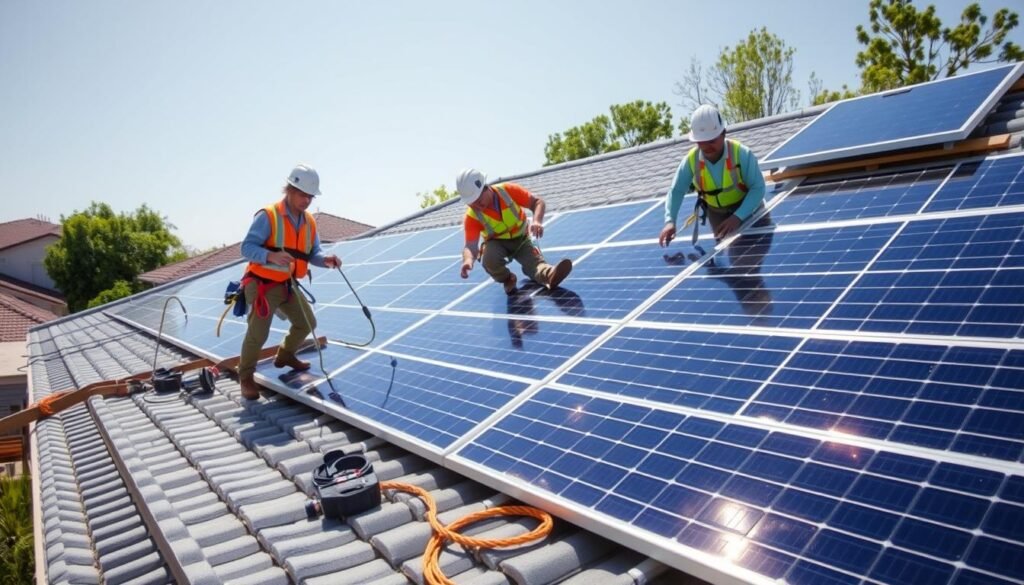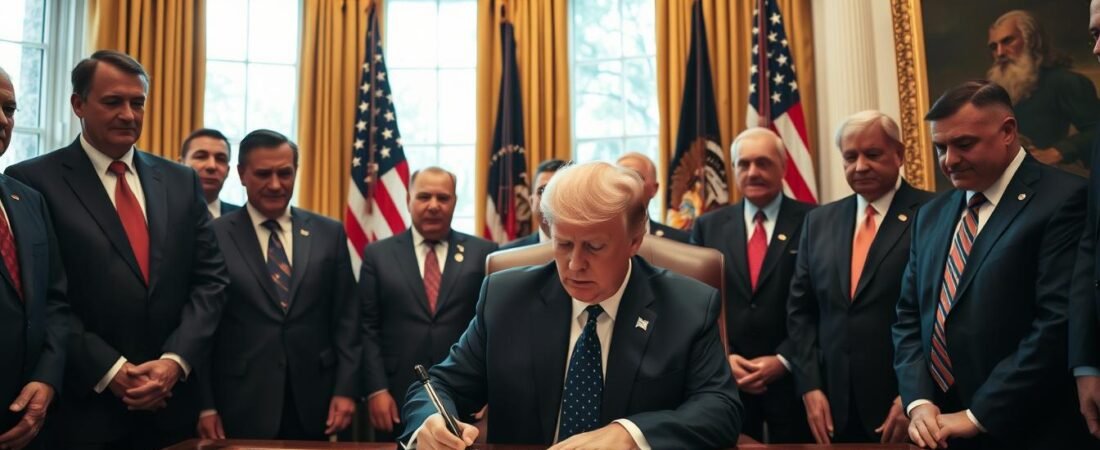President Donald Trump’s sweeping “Big Beautiful Bill” has now been signed into law, bringing major changes to America’s tax code, social programs, and economic landscape. With proponents claiming it will spark job creation and critics warning of widespread layoffs, American workers are caught in the middle of conflicting narratives. This comprehensive analysis examines the bill’s likely workforce impacts across sectors, providing clarity on which industries may see growth and which face potential contraction.
Stay Informed on Economic Policy Impacts
Get expert analysis on how changing policies affect your industry and career prospects. Our weekly newsletter delivers insights you won’t find elsewhere.
Understanding Trump’s “Big Beautiful Bill” and Its Workforce Implications
President Trump signed the nearly 900-page legislation on July 4, 2025, following narrow passage in both chambers of Congress.
The $4.5 trillion package makes permanent Trump’s 2017 tax cuts while adding new tax relief measures, including deductions for overtime pay, tip income, and auto loans. Simultaneously, it enacts deep spending cuts to social safety net programs such as Medicaid and SNAP (food stamps), while significantly expanding immigration enforcement funding.
According to Congressional Budget Office analysis, the bill’s impacts will be unevenly distributed: higher-income Americans are projected to receive an average tax benefit of $12,000, while the lowest-income Americans could face an additional $1,600 in costs annually due to program cuts.
But beyond these broad economic effects, the legislation contains numerous provisions that will directly impact American workers and job markets. From manufacturing incentives to healthcare sector restructuring, the bill’s employment effects will vary dramatically by industry, region, and worker demographic.
Tax Changes and Their Employment Effects

Small business owners are evaluating how the bill’s tax provisions will affect their hiring decisions.
Business Tax Incentives
The legislation allows businesses to immediately write off 100% of equipment and research costs, which economists at the Tax Foundation project could stimulate capital investment and potentially create 300,000 new jobs over the next five years, primarily in manufacturing and technology sectors.
However, these gains may be concentrated in specific regions and industries. States with strong manufacturing bases like Ohio, Michigan, and Pennsylvania could see the greatest benefits, while service-economy dominated states may experience less direct job growth from these provisions.
Worker-Specific Tax Breaks
The bill creates temporary tax deductions for tip income (up to $25,000 annually) and overtime pay (up to $12,500 for individuals, $25,000 for married couples). These provisions, in effect from 2025 through 2028, could incentivize workers in service industries and manufacturing to take on additional hours.
“These targeted tax breaks could increase labor force participation in key sectors facing worker shortages,” notes economist James Lucier of Capital Alpha Partners. “However, the temporary nature of these provisions creates uncertainty about their long-term workforce impacts.”
Senior Workforce Impacts
The $6,000 “senior bonus” deduction for Americans 65 and older earning under $75,000 ($150,000 for couples) could affect retirement decisions. Labor economists suggest this might encourage some older workers to remain in or return to the workforce, potentially increasing competition for positions in sectors with high concentrations of older workers.
Industry-Specific Workforce Projections

Clean energy sector workers may face job uncertainty as tax credits for renewable energy are eliminated.
Clean Energy Sector Contraction
One of the most significant workforce impacts comes from the elimination of clean energy tax credits. The $7,500 tax credit for electric vehicles and incentives for home energy efficiency upgrades will end by late 2025, much earlier than their original 2032 expiration date.
The Solar Energy Industries Association estimates this could result in the loss of up to 100,000 jobs in solar installation, manufacturing, and related fields. States like California, Texas, and Florida, which lead in renewable energy employment, would be most affected.
“We’re already seeing companies pause hiring and expansion plans,” said Jennifer Granholm, former Energy Secretary. “The abrupt elimination of these incentives creates significant workforce disruption in what has been one of America’s fastest-growing employment sectors.”
Healthcare Employment Shifts

Healthcare providers are assessing staffing needs as Medicaid funding changes take effect.
The $1 trillion in Medicaid cuts will significantly impact healthcare employment. The American Hospital Association projects that rural hospitals, which rely heavily on Medicaid reimbursements, could face staffing reductions of 5-15% as funding decreases.
Simultaneously, the new work requirements for Medicaid recipients could create administrative jobs to manage compliance verification, though these gains would likely be outweighed by broader healthcare employment losses.
Immigration Enforcement Expansion
The bill allocates $31 billion for Immigration and Customs Enforcement (ICE) to hire more agents and increase deportations. This represents one of the few areas of direct federal job creation in the legislation, with an estimated 15,000 new positions in enforcement, administration, and detention facility operations.
Border states like Texas, Arizona, and California will see the most significant employment gains in this sector, though economists note these jobs may come at the expense of other industries that rely on immigrant labor.
Regional Workforce Winners and Losers
Manufacturing Belt Resurgence
States with strong manufacturing sectors could see significant job growth due to equipment expensing provisions and auto loan interest deductions. Ohio, Michigan, Indiana, and Pennsylvania may experience manufacturing employment increases of 2-4% over the next three years, according to Oxford Economics projections.
“The immediate expensing provision is particularly powerful for capital-intensive industries,” explains economist Mark Zandi of Moody’s Analytics. “We expect to see accelerated investment in automation and production capacity, though the net employment effect depends on whether productivity gains outpace production increases.”
Clean Energy States Face Headwinds
States that have invested heavily in renewable energy infrastructure and manufacturing face potential job losses as clean energy tax credits disappear. California could lose up to 40,000 clean energy jobs, while Nevada, Arizona, and Colorado may see significant contractions in their solar and wind energy workforces.
These losses could be partially offset by growth in traditional energy sectors, though the transition may create significant short-term displacement for workers with specialized skills in renewable technologies.
Get State-Specific Workforce Impact Analysis
How will your state’s job market respond to the new legislation? Download our detailed regional impact report with industry-specific projections.
Demographic Workforce Impacts

The bill’s provisions will affect different demographic groups in varying ways, from seniors to service workers.
Service Industry Workers
The tax deduction for tip income could benefit approximately 5.3 million workers in food service, hospitality, and personal care industries. However, these same workers may be disproportionately affected by Medicaid and SNAP cuts, as they often rely on these programs to supplement lower wages.
Restaurant industry analysts project the tip income deduction could increase server retention by 15-20% in full-service restaurants, potentially addressing chronic staffing shortages in the sector.
Older Workers
The “senior bonus” deduction could incentivize continued workforce participation among older Americans. The Urban Institute projects this could increase labor force participation among those 65-70 by up to 2 percentage points, adding approximately 300,000 older workers to the labor force.
This trend could create both opportunities and challenges for employers, providing experienced workers while potentially delaying advancement opportunities for younger employees in certain sectors.
Low-Income Workers
The combination of Medicaid and SNAP work requirements will significantly impact low-income workers. The legislation requires most able-bodied adults under 65 to work at least 80 hours monthly to maintain benefits, with limited exemptions for those with dependent children under 14.
Labor economists project this could push approximately 4 million additional people into the workforce, primarily in entry-level service and retail positions. However, the quality and stability of these jobs remain significant concerns.
Historical Comparison: Workforce Impacts of Major Economic Legislation
To understand the potential workforce impacts of Trump’s legislation, it’s instructive to examine the employment effects of previous major economic bills:
| Legislation | Administration | Key Provisions | Workforce Impact |
| Economic Recovery Tax Act | Reagan (1981) | 23% reduction in individual tax rates; accelerated depreciation | Initial job losses during 1981-82 recession; 11.5 million jobs created 1983-88 |
| Bush Tax Cuts | Bush (2001/2003) | Reduced income tax rates; expanded child tax credit | 5.6 million jobs created 2003-07; criticized for weak job growth relative to previous expansions |
| Affordable Care Act | Obama (2010) | Healthcare coverage expansion; insurance market reforms | Created estimated 240,000 healthcare jobs; reduced “job lock” by providing insurance options outside employment |
| Tax Cuts and Jobs Act | Trump (2017) | Corporate tax rate reduction; temporary individual tax cuts | 6.7 million jobs created 2018-20 pre-pandemic; business investment growth below projections |
| Inflation Reduction Act | Biden (2022) | Clean energy investments; healthcare subsidies | Created estimated 100,000+ clean energy jobs; healthcare employment stabilization |
“Historical comparisons suggest that while tax cuts typically stimulate some job growth, the relationship is neither automatic nor uniform across sectors,” explains economist Austan Goolsbee, former Chairman of the Council of Economic Advisers. “The employment effects of Trump’s bill will likely be more mixed than either supporters or critics suggest, with significant variation by industry, region, and worker skill level.”
Expert Perspectives on Workforce Impacts

Economic experts offer varying perspectives on the bill’s likely employment effects.
“The bill’s business investment incentives will likely create jobs in manufacturing and construction, but these gains may be offset by contractions in healthcare and renewable energy. The net effect on employment will be modest but unevenly distributed across regions and industries.”
“By making the 2017 tax cuts permanent and adding new business incentives, this legislation will unleash American economic potential. We project it could create up to 2 million new jobs over the next five years through increased business investment and consumer spending.”
“The cuts to Medicaid and social programs will create significant hardship for low-wage workers while providing minimal job creation benefits. The bill represents a massive transfer of resources from working families to corporations and wealthy individuals.”
“The elimination of clean energy tax credits will devastate one of America’s fastest-growing employment sectors. We estimate up to 150,000 jobs could be lost in solar, wind, and related industries, with ripple effects throughout the supply chain.”
Workforce Impacts: Pros and Cons Analysis

Analysts are weighing the potential positive and negative workforce impacts of the legislation.
Potential Positive Workforce Impacts
- Business equipment expensing could create 300,000+ manufacturing jobs
- Auto loan interest deduction may boost automotive industry employment
- Tip income and overtime deductions could increase worker retention in service industries
- Immigration enforcement expansion creates 15,000+ federal jobs
- Senior tax bonus could increase older worker participation by 300,000
- Medicaid/SNAP work requirements may increase labor force participation
- Permanent tax cut extension provides business planning certainty
Potential Negative Workforce Impacts
- Clean energy sector could lose 100,000+ jobs from eliminated tax credits
- Healthcare providers may cut 200,000+ positions due to Medicaid funding reductions
- Rural hospitals face staffing reductions of 5-15%
- Low-wage workers may face reduced hours to maintain benefit eligibility
- Temporary nature of some tax provisions creates future uncertainty
- Immigration enforcement may reduce labor supply in agriculture, construction, and hospitality
- State and local governments may reduce workforce due to increased Medicaid costs
Frequently Asked Questions: Workforce Impacts of Trump’s Big Beautiful Bill

Workers across industries have questions about how the legislation will affect their employment prospects.
Which industries are most likely to see job growth under the bill?
Manufacturing, traditional energy production, automotive, and immigration enforcement are projected to see the strongest job growth. The immediate expensing provisions for business equipment should stimulate manufacturing employment, while the auto loan interest deduction may boost automotive sales and production. The significant funding increase for immigration enforcement will create thousands of federal positions.
Which sectors face the greatest risk of job losses?
Renewable energy, healthcare, and social services face the highest risk of job contraction. The elimination of clean energy tax credits will likely reduce employment in solar, wind, and related industries. Healthcare providers, particularly those serving Medicaid populations, may reduce staffing in response to funding cuts. State and local government employment may also decline as states absorb higher Medicaid costs.
How do the workforce impacts compare to Trump’s 2017 tax reforms?
While both packages feature tax cuts, the current legislation has more targeted provisions affecting specific worker groups (tip income, overtime, seniors) and includes deeper spending cuts to offset costs. The 2017 reforms were primarily focused on corporate tax rates and broader individual tax brackets, while the current bill combines tax policy with significant changes to social programs and immigration enforcement that directly impact labor markets.
Will the Medicaid and SNAP work requirements create jobs?
The work requirements will likely increase labor force participation, potentially adding 3-4 million people to the workforce. However, economists debate whether this will translate to actual job creation or simply increase competition for existing positions, potentially driving down wages in entry-level jobs. Some administrative jobs will be created to manage compliance verification, but these gains may be offset by broader healthcare employment losses due to Medicaid funding reductions.
How will the bill affect gig workers and independent contractors?
The legislation makes permanent the Section 199A deduction for pass-through businesses, which benefits many independent contractors and gig workers. This provides tax certainty for this growing segment of the workforce. However, gig workers who currently rely on Medicaid or SNAP benefits may face new work verification requirements that could be challenging to meet given the variable nature of gig work schedules.
Conclusion: A Workforce in Transition

The full workforce impacts of Trump’s Big Beautiful Bill will unfold over years as markets adjust to new incentives and constraints.
Trump’s Big Beautiful Bill represents one of the most significant economic policy shifts in recent American history, with far-reaching implications for workers across industries, regions, and demographic groups. While proponents argue it will unleash economic growth and job creation through business investment incentives, critics contend the benefits will be unevenly distributed and offset by contractions in sectors facing funding cuts or eliminated tax credits.
The reality likely falls somewhere in between these competing narratives. The legislation will create winners and losers in the labor market, with manufacturing, traditional energy, and immigration enforcement seeing potential growth, while renewable energy, healthcare, and social services face headwinds. The regional distribution of these impacts will be uneven, potentially exacerbating existing economic disparities between states and communities.
As workers and businesses navigate this changing landscape, staying informed about industry-specific impacts and potential transition opportunities will be essential. The full workforce effects of this sweeping legislation will only become clear in the years ahead as markets adjust to new incentives and constraints.
Stay Ahead of Workforce Trends
Join our expert webinar series analyzing the evolving impacts of economic policy on employment markets and career opportunities.
